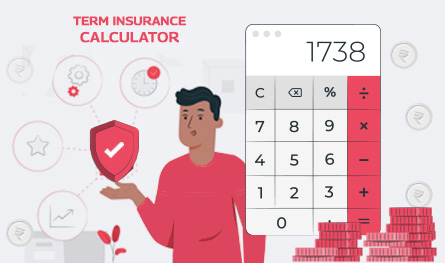How Much Term Insurance Coverage Do You Really Need?
.png)
Term insurance is an extremely crucial necessity. It acts as a financial security net for your beloved family without much pocket pinch. Term plans also allow tax benefits along with enhanced life coverage protection.
However, you must ensure that you get the most out of it once you purchase it. This calculation is quite crucial to exercise your term cover to the fullest.
.png)
But, before that, you need to understand the concept of term insurance well.
What is term insurance?
Term Insurance is a pure life insurance plan. It is the cheapest way to get high coverage, as there is usually no element of savings in Term Plans.
So, just like other life insurance plans, term insurance plans are also mutual contracts between the insurer and the insured, where the term life cover protects the family members of the insured individual if he faces an untimely demise. Thus, if the life insured dies within the policy tenure, the insurer will pay the entire Term Insurance coverage to the nominee, and the policy will be terminated.
However, nothing is usually payable as a maturity benefit if the life assured outlives the entire policy tenure. This is why Term Plans are often referred to as the cheapest and purest form of life insurance.
Factors to consider for calculating the optimum term life cover
The crucial factors that you need to consider for calculating the optimum term insurance coverage include:
Budget:
Making a critical budget is the primary step. You must maintain a super realistic approach to achieve the best. You must determine your affordability to make the best decision. This way, premium payments will not become taxing.
Tip: If the premium amount seems to be too high, you may initially begin with a lower premium amount and then gradually increase the coverage extent with additional riders to the existing plan and shift to another comprehensive plan.
Age:
Age is a significant determinant here. While you are in your 20s or 30s, you gradually become the principal breadwinner in the family. At this juncture, you require an essentially huge life coverage so that your family’s financial position does not get jeopardised despite your absence. They can utilise this life coverage to pay off their debts and pay the bills.
Tip: You must buy this young because your health risks are relatively low, so the premium rates are also low.
Note: Term insurance premiums are locked once the policy is issued. So, if you can opt for a higher coverage at a lower age, you would end up saving a lot of premium and can also avail Income Tax benefits for all those years that you have paid the premiums.
Family size:
This is a powerful determinant here. If you are the principal earning member in the family, consisting of yourself, your spouse, 2 young kids, and dependent parents, then you need to choose the coverage based on your financial liabilities. The size of your family determines your monthly household expenses, which in turn would influence your life insurance requirement.
Tip: You must critically calculate the total number of family members to ensure optimum term insurance coverage, sufficient for all.
Income sources:
You could be the sole bread earner for your family, but you could also have other sources of income. If you have passive income, such as rental income, etc. then your overall financial liability could reduce.
Also, there could be other income sources, such as multiple members earning in the family, pensions for the senior members, etc. as well. In these cases, your life insurance requirement could be lower as well.
Tip: You would require a large life coverage if you are the only earning member in the family.
Family lifestyle:
The overall family lifestyle and choices are also crucial in determining the life coverage required. If you live in a posh apartment in the middle of a metro city, your kids go to the best available schools, and you certainly would not want your family to compromise with the status after your demise.
Tip: If you don’t want your family to compromise with their financial habits and status, your term life calculation must consider all these factors.
Debt:
Debt is another major considerable factor here. In case your portfolio has outstanding home loans/ business loans/mortgaged property, your life cover must be high enough to cover all these. This is essential as these loans are often long-term. In case you pass away in between, your family will not have to face difficulties in riding them off.
Tip: The total debt amount needs to be added to your term insurance coverage requirement if you do not want your family to keep repaying them in your absence!
Future goals:
Your term life planning will include all your financial targets. It can be children’s education, marriage, etc. The corpus must be enough to handle these milestones efficiently.
Tip: Plan your future financial goals in such a manner that you specify the amount and the timelines accordingly so that you can fulfil them seamlessly. Insurance is always considered your Plan B, i.e. in case you cannot follow Plan A.
Term life calculation
Your term life calculation must exclusively depend on you and your family only and not any of your friends or relatives. Some common methods of calculating term insurance coverage include:
- Human Life Value: This is a common approach for insurance companies. They often use a Human Life calculator to determine the financial stature of the concerned individual in the family. However, you must note that each insurance company observes a different approach here, which will alter the results based on your chosen insurer. However, the common factors of consideration include gender, age, retirement age, current savings, annual income, etc.
- Income replacement value: This is estimated by Current annual income x no. of years remaining for retirement. This way, the breadwinner’s total income is focused on determining the coverage required after his/her demise.
- Expense replacement: The financial structure of any family gets jeopardised in more ways than one after the sole breadwinner passes away. However, after calculating the total expenses, including outstanding debts and loans, you can assess your future financial requirements and proceed accordingly.
- Underwriter’s thumb rule: Here, the concerned individual chooses to maintain a sum insured which is multiple times over their current annual income. Some experts opine to make it 10 times more than your current annual income from all the sources.

Author Bio
Paybima Team
Paybima is an Indian insurance aggregator on a mission to make insurance simple for people. Paybima is the Digital arm of the already established and trusted Mahindra Insurance Brokers Ltd., a reputed name in the insurance broking industry with 17 years of experience. Paybima promises you the easy-to-access online platform to buy insurance policies, and also extend their unrelented assistance with all your policy related queries and services.
Other Life Insurance Products
Latest Post

If you think of life insurance, chances are you are picturing something people buy in their 30s or 40s. But what if you are 65 or older and just getting started? The good news is that you are never too late. Whether you are thinking of easing the financial burden on your family, covering final expenses, or simply leaving behind a legacy, there are life insurance options tailored just for you.
This article will be a guide to life insurance for senior citizens above 65 years, explaining why it is important, the type of insurance options, and how to get the right policy for you.


Have you ever caught yourself lost in illusions about your daughter's future events, such as her university convocation and first day at work? Her university convocation. When she embarks upon her initial job after graduation will be the day.


Let’s be honest – life insurance planning isn’t exactly someone’s weekend hobby. It is the financial equivalent of flossing: we understand its importance, but we tend to put it off. But somewhere between balancing work and life, you might realise you need to have a solid plan in place – just in case.


We all know that health insurance policies offer a long list of inclusions. However, exclusions are also a crucial aspect of every policy. Overlooking policy documents can surprise you with hidden clauses that you didn't even know existed. To avoid such unpleasant situations and unexpected expenses during medical emergencies, it is crucial to uncover hidden clauses your health insurance policy may contain. When you buy health insurance online, make sure to know all about the policy before signing the document.
From least known exclusions to waiting periods and conditions in the fine print, hidden clauses can affect your overall experience. To help you out, here are the top hidden clauses of a health insurance policy that you should know.

.png)
Lymphocytes, a kind of white blood cells, are an extraordinary army of defenders functioning in the bustling world of our immune system for our body’s immune defence. Let’s know about these mighty warriors who are continually waging war against invading pathogens, viruses, and microbes in detail.




